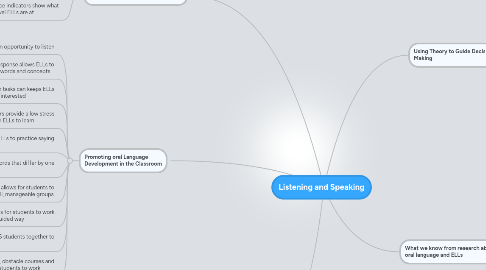Listening and Speaking
by Nate Gruber


1. Using Standards to Focus Instruction
1.1. Common core is created for native english speakers
1.2. Model performance indicators show what developmental level ELLs are at
2. Promoting oral Language Development in the Classroom
2.1. ELLs must have an opportunity to listen
2.2. Total Physical Response allows ELLs to visualize english words and concepts
2.3. Listening comprehension tasks can keeps ELLs focused, challenged and interested
2.4. Listening centers provide a low stress environment for ELLs to learn
2.5. Oral retelling allows for ELLs to practice saying keywords or phrases
2.6. Minimal pairs are words that differ by one phoneme
2.7. Cooperative learning allows for students to learn together in small, manageable groups
2.8. Think-pair-share allows for students to work with each other in a guided way
2.9. Roundtable puts 3 to 6 students together to help brainstorm ideas
2.10. Role play, barrier games, obstacle courses and acting are fun ways for students to work together and develop language skills
2.10.1. Several technologies can helps ELLs practice their speaking

